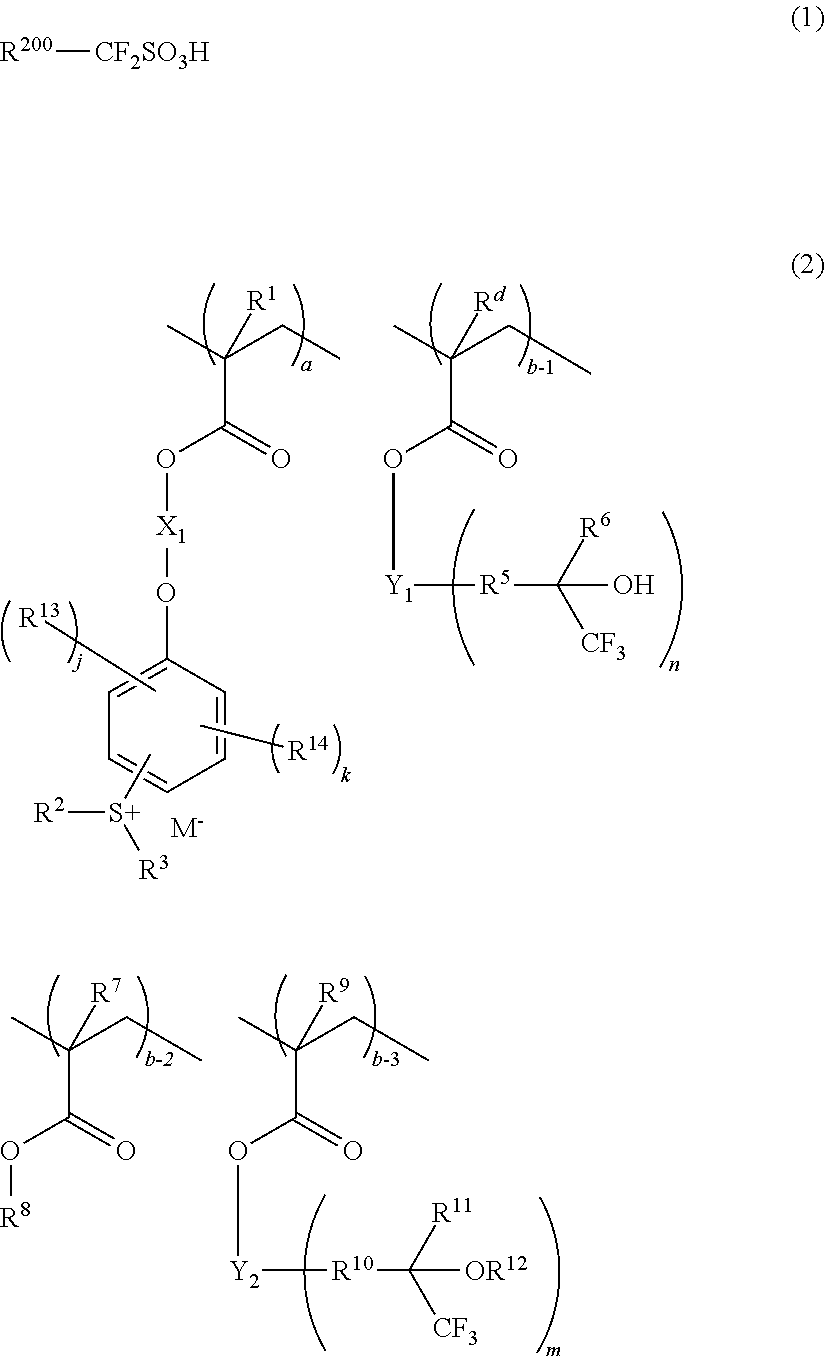Resist composition and patterning process using the same
a composition and composition technology, applied in the field of resist composition, can solve the problems of change of optical system, increase of scanner cost, poor sustainability of soft, etc., and achieve excellent pattern rectangularity, resist composition, and resist the effect of falling
Inactive Publication Date: 2012-08-23
SHIN ETSU CHEM IND CO LTD
View PDF9 Cites 19 Cited by
- Summary
- Abstract
- Description
- Claims
- Application Information
AI Technical Summary
Benefits of technology
[0050]In the patterning process using the resist composition of the present invention, especially in the case of an immersion exposure using water, patterning can be done excellently and a blob defect can be prevented from occurring even when a top coat is formed in the immersion exposure as mentioned above.
[0051]As mentioned above, the present invention ca
Problems solved by technology
However, there are many problems in an F2 lithography; an increase in cost of a scanner due to the use of a large quantity of expensive CaF2 single crystals for a projector lens, extremely poor sustainability of a soft pellicle, which leads to a change of an optical system due to introduction of a hard pellicle, a decrease in an etching resistance of a resist film, and the like.
However, in an immersion lithography, many problems caused by presence of water on a resist film have been pointed out.
Because of such a high speed scanning, water cannot be kept between a projection lens and a wafer, thereby causing a problem of a remaining liquid droplet on a photoresist surface after scanning.
It is assumed that this remaining liquid droplet causes poor patterning.
However, there appeared a new problem by use of the top coat and the additive that are hydrophobic as mentioned above; namely, a defect caused by a residue remained on a resist film after development, called a blob, is drawing an attention.
In an immersion exposure using a top coat, a highly hydrophobic top coat is remained on surface of the resist film even after development because of mixed dissolution of the top coat with the resist film (this is called “mixing”) thereby causing the blob defect on the resist film.
In the case of an immersion exposure not using the top coat by using a hydrophobic additive, the blob defect appears when the additive is not sufficiently remove
Method used
the structure of the environmentally friendly knitted fabric provided by the present invention; figure 2 Flow chart of the yarn wrapping machine for environmentally friendly knitted fabrics and storage devices; image 3 Is the parameter map of the yarn covering machine
View moreImage
Smart Image Click on the blue labels to locate them in the text.
Smart ImageViewing Examples
Examples
Experimental program
Comparison scheme
Effect test
 Login to View More
Login to View More PUM
 Login to View More
Login to View More Abstract
There is disclosed a resist composition, wherein the composition is used in a lithography and comprises at least: a polymer (A) that becomes a base resin whose alkaline-solubility changes by an acid, a photo acid generator (B) generating a sulfonic acid represented by the following general formula (1) by responding to a high energy beam, and a polymer additive (C) represented by the following general formula (2). There can be provided a resist composition showing not only excellent lithography properties but also a high receding contact angle, and in addition, being capable of suppressing a blob defect in both the immersion exposures using and not using a top coat; and a patterning process using the same.
Description
BACKGROUND OF THE INVENTION[0001]1. Field of the Invention[0002]The present invention relates to a resist composition used for microfabrication in manufacturing process of a semiconductor device and so on, for example, for a lithography using an ArF excimer laser of a 193 nm wavelength as a light source, especially for an immersion photolithography in which water is inserted between a projection lens and a wafer, and to a resist patterning process using the same.[0003]2. Description of the Related Art[0004]Conventionally, optical exposure has been widely used using g-line (436 nm) or i-line (365 nm) of a mercury-vapor lamp as a light source for lithography when a resist pattern is formed. As a mean for further miniaturization, shifting to a shorter wavelength of an exposing light was assumed to be effective. As a result, in a mass production process after DRAM (Dynamic Random Access Memory) with 64-megabits (0.25 μm or less of a processing dimension) in 1990s, a KrF excimer laser (2...
Claims
the structure of the environmentally friendly knitted fabric provided by the present invention; figure 2 Flow chart of the yarn wrapping machine for environmentally friendly knitted fabrics and storage devices; image 3 Is the parameter map of the yarn covering machine
Login to View More Application Information
Patent Timeline
 Login to View More
Login to View More IPC IPC(8): G03F7/20G03F7/027
CPCG03F7/0045G03F7/0046G03F7/2041G03F7/0397G03F7/11G03F7/0382H01L21/0273
Inventor KOBAYASHI, TOMOHIROOHSAWA, YOUICHIHARADA, YUJISUKA, YUKI
Owner SHIN ETSU CHEM IND CO LTD
Features
- R&D
- Intellectual Property
- Life Sciences
- Materials
- Tech Scout
Why Patsnap Eureka
- Unparalleled Data Quality
- Higher Quality Content
- 60% Fewer Hallucinations
Social media
Patsnap Eureka Blog
Learn More Browse by: Latest US Patents, China's latest patents, Technical Efficacy Thesaurus, Application Domain, Technology Topic, Popular Technical Reports.
© 2025 PatSnap. All rights reserved.Legal|Privacy policy|Modern Slavery Act Transparency Statement|Sitemap|About US| Contact US: help@patsnap.com



